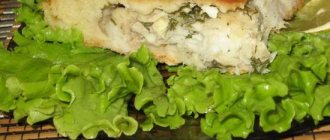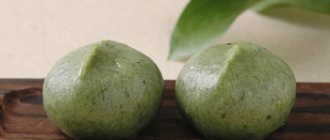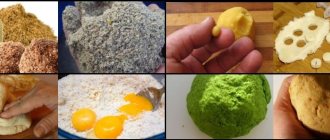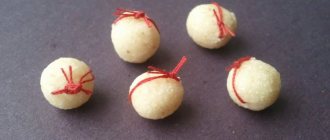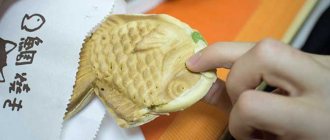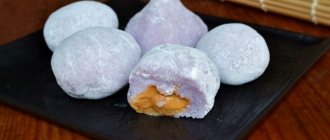Takoyaki, or octopus balls, are one of Japan's most famous street snacks, originating in Osaka. Whether you make traditional takoyaki with pieces of octopus or other fillings, these ball-shaped dumplings are fun to make with friends or family.
Takoyaki (たこ焼き) is a Japanese snack shaped like small round balls filled with pieces of octopus. Takoyaki literally translates to "fried/fried octopus", so some people call them "octopus balls" or "octopus dumplings".
Facts about takoyaki
Here are some fun facts about this dish:
- They emerged and became popular in Osaka around 1935, and then spread to much of south-central Japan and beyond.
- It is one of the most popular Japanese street snacks along with okonomiyaki.
- Takoyaki is commonly sold by street vendors, convenience stores, supermarkets, food courts and, of course, specialty restaurants. In Osaka, takoyaki shops can be easily found all over the city.
- The dish is usually served with a slightly salty takoyaki sauce, which goes well with beer and other alcoholic drinks. That's why many Izakaya restaurants offer takoyaki on the menu.
Devices and tools
For the Japanese, filled dough balls are the most common dish. Enterprising chefs even cook it on the streets. Moreover, they all use the same takoyaki recipe. Any passerby can stop, wait a little and get his portion of the famous national fast food. In addition to food products, any cook needs special equipment and tools to work:
- Such a girl. This is a special frying pan with several spherical recesses. It can be installed directly on the stove or use the electrically heated option.
- Device for turning workpieces. It resembles a screwdriver.
- Brush for lubricating the surface of the plate. It is better if it is made of silicone.
To make such magic balls yourself, you need a special takoyaki set, which, in principle, consists of these three tools. As a rule, it is found in every Japanese family.
Three tips for making perfect takoyaki
These tips were shared by a resident of Osaka, who has a direct connection to Japanese cuisine, so you should definitely take them into account.
- Use LOTS of oil. Make sure you have enough oil in the pan as it helps ensure the takoyaki gets a crispy finish, which means it will be easier for you to flip it as the batter won't stick to the surface.
- Sufficient amount of batter. The entire top of the grill should be covered with batter after adding the octopus and other ingredients. The dough should fill all the free space in the pan.
- Turn the takoyaki 90 degrees and add more batter. Remove excess dough from around the wells using skewers. Once the bottom of the takoyaki balls are crispy, turn them 90 degrees to allow the raw batter to pour into the hole. Fill and press additional dough inside the balls. This will help make their shape perfectly round. You may not quite understand what we are talking about right now, but as you cook, you will figure it out.
When preparing takoyaki at home, be careful to ensure that all the balls are browned evenly.
Takoyaki - homemade octopus balls
December 6, 2015
Japanese cuisine has its own sphere of vulgar mayonnaise-yums - rather meaningless in composition, invented out of poverty, but with a bright taste that is close to base urges. This is street festival food - yakisoba, okonomiyaki, yakitori, takoyaki. But, unlike the canonical sandwiches with mayonnaise (recently a masseuse complained that dad taught the children to eat bread with mayonnaise! How so! I explained to her that mayonnaise is something supranational, cosmic), these dishes have a history, a style, an established image, This is already a classic. Hand on heart, the only thing I don’t like out of all this is yakitori, I eat the rest with pleasure if it’s well cooked, less butter, more tasty meat and vegetable fillings.
Takoyaki, I heard, came to Russia, is that true? It seems they have begun to appear in Moscow. These are quickly fried balls of batter with a filling that is supposed to contain a piece of octopus. This is a quick meal on the go, often sold in 6, 8 or 12 balls in Japan. There are a million versions of what and how can be fried in this way, but takoyaki is basically unchanged among the Japanese, only the topping changes - on top you can throw minimally powdered nori seaweed and bonito flakes, or add grated cheese, caviar, green onions, citrus sauce.
In our grocery store there is a small queue at the takoyaki kiosk around lunchtime, and on weekends you can wait for at least 20-30 minutes. Apparently I'm not the only one who thinks it's delicious! Recently it dawned on me, and for 20 bucks I bought a takoyaki pan - just a non-stick pan with hemispherical pits. It can be placed on any gas source, for some reason I took a mini-stove for the first time, on which we cook nabe on the table, although I have a gas stove, and it’s absolutely the same. I don’t know how it will behave on an electric stove... but the balls themselves are unpretentious to the uniformity of heat, so it may be fine on it.
The idea of takoyaki is this: first, the molds are filled about a third full with liquid dough, then octopus is put in, then a little more textured filling, and more dough on top, and then turn it all over, fry, take it out and pour in the sauce for richness. I think there is room for gastronomic imagination. But I’m not good with imagination, even just repeating at home what people have been cooking in this country for centuries is already a kind of feat, and even entertainment
I took this octopus - it is lightly boiled, elastic and quite soft, suitable for eating in this form; there is no need to cook it further. I think you can replace it with squid, why not shrimp? The dish will not be canonical, of course, but here I mean precisely the scope for creativity in the kitchen.
Next, the dough. I took a takoyaki mixture - it has flour mixed with other ingredients, and there are a lot of them: there is powdered dashi, the dried crushed root of this slippery tuber, which gives it a snotty texture, starch, soy sauce, flavorings. Additives make the dough airy - at the end we don’t get a ball of dough, but something quite fluffy. The mixture must be mixed with eggs and water, proportion: 100 g of flour mixture, 1 egg and 300 ml of water. From this I got about 20 small balls.
Filling, in addition to octopus: the Japanese suggest adding “something you love” - chopped cabbage, for example, but it is very advisable to add green onions and tenkasu. Tenkasu is an amazing invention of the Japanese famine era. Has everyone seen how tempura is fried? Vegetables and seafood in batter. Just imagine the pieces of this batter that fall off during deep frying. Now, if they are of the same round shape, dried and cleared of excess oil, this is tenkasu. The product is meaningless and greasy, but in takoyaki and okonomiyaki it adds volume and airiness.
59 kcal per 10 g, OMG, as they say
A big discovery for me was that pickled ginger, tinted with a feather bed in a bright red color, in the takoyaki department is sold in small packaging, for 1 serving. I sometimes love this ginger, but I can’t eat a lot, and no one eats it except me, and I had to buy a larger package, eat it once and throw it away (((In the first weeks of pregnancy, not yet knowing what was wrong with me, I I was throwing it around like crazy, those were the times... yes... At the same time, I don’t eat the light ginger that comes with sushi at all, I can’t eat a single piece) It’s a paradox!
It is desirable to add this red ginger to the filling, but many people do not like it, so sometimes it is served separately in a heap. It perfectly sets off the overall bright taste composition of this grunt.
And so, we fry. People who fry takoyaki in public catering look very concentrated, and I thought it was difficult, I almost bought a special metal stick for turning. It turned out that in a non-stick form and ordinary wooden skewers everything turns over perfectly, but you could get by with a fork. First, pour in a little dough, wait for it to set, throw in the octopus, then a little tenkasu mixed with green onions and ground nori, and pour the dough on top.
We turn the balls over, picking up the remaining batter from the edges, they turn up and fry without problems.
All!
Top with sweet and sour sauce with an incomprehensible but comprehensive taste,
and for authenticity, sprinkle with mayonnaise, you should, in theory, use a nozzle with a small hole, but I didn’t have one. “Thunderstorm in early May” style mayonnaise looks great on takoyaki. It is also advisable to sprinkle ground nori on top - these are not the nori that are pressed with leaves, they are greener and less moist, but the taste is similar. You can also sprinkle katsuobushi fish flakes - or bonito, according to you :)) But in Japan, all these additives are classic, but optional, people always ask about them whether they are necessary or not. In fact, they add all the flavor to this primitive, uncomplicated dish)) But based on it, you can come up with a lot of things, I’m sure.
Ingredients
Prepare everything you need in advance, namely:
- 2 onions,
- 1 tbsp. spoon pickled red ginger (beni shoga),
- 120 grams of boiled octopus,
- ¼ cup (4 grams) katsuobushi (dried bonito flakes)
- 1 cup (120 grams) plain flour,
- 2 tsp. baking powder,
- ½ tsp. kosher sea salt (or half as much table salt),
- 2 large eggs,
- 1 tsp. soy sauce,
- 1½ cups (360 ml) dashi
- 2 tbsp. spoons of vegetable oil,
- 15 grams tenkasu (leftover tempura).
For filling:
- takoyaki sauce (tonkatsu sauce),
- Japanese mayonnaise,
- katsuobushi (dried bonito flakes),
- aonori (dried green seaweed).
Takoyaki with cabbage and fish sauce
There are many recipes for making takoyaki at home. They say that every Japanese home has its own family recipe for takoyaki. We present to your attention another cooking option.
- 1 tbsp. white flour;
- 2 large spoons of sweet soy sauce;
- 1 small spoon of fish sauce;
- 1 small spoon of white sugar;
- 1 egg;
- 1 chip soda;
- 2/3 tbsp. cold water;
- 1 guest crab meat (chopped);
- 1 handful of boiled octopus (chopped);
- 2 tbsp. a mixture of finely chopped Chinese cabbage, parsley, onions and dill.
- half a small spoon of fish sauce;
- 1 large spoon of ketchup;
- 1 large spoon of sweet soy sauce;
- half a small spoon of grated ginger;
- half a small spoon of Tabasco sauce.
- Mix flour, eggs, and water into a liquid, homogeneous dough. In the process, add sauces, sugar and soda. It is important to follow the specified proportions so that the dough reaches the required consistency. In specialized stores you can find a special flour mixture for takoyaki, then preparing the dough for the snack is greatly simplified.
- Pour the batter into a heated and greased takoyaki pan until it completely fills all the indentations.
- Now is the time to spread out the filling. It is better to place the octopus pieces individually in each hole. And all the other ingredients (crab meat, shredded cabbage with herbs) can be scattered directly over the entire surface.
- Once the dough has thickened and set, carefully turn the balls over to the other side. We carefully select everything that does not fall into the holes and tuck it under the bottom of the balls. The donut flipping pattern consists of 3-5 turns. Then they will acquire the correct rounded shape and be better prepared.
- Place the finished Japanese donuts on a serving plate.
- From these ingredients we prepare a delicious aromatic takoyaki sauce and pour it over the appetizer. Additionally, you can decorate with dried squid, grated crab sticks or nori seaweed. The dish is served hot. Bon appetit everyone!





